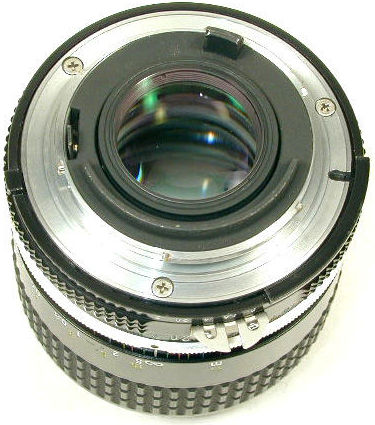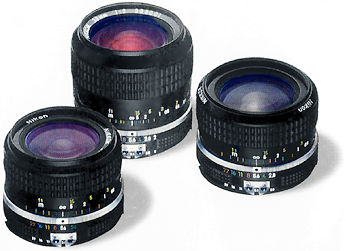Ai Nikkor 28 mm f/2.0, f/2.8 & f/3.5 lenses
At the beginning of the '70, Nikkor 28mm lenses have gained its popularity with increasing number of photographers who often find this focal length so useful in handling commercial, industrial, architectural, travel, landscape and news photography. The Ai lens coupling system used in the updated metering system employed by Nikon SLRs during the late seventies also saw many of the lenses went through the important transitional Ai change. Like many other Nikkor lenses, these lenses can also be easily identified from earlier ones with its new improved cosmetic changes which carried a more modern Nikkor feel and appearance. The most noticeable feature is the dual aperture rings that contains the aperture settings and direct readout scales. The aperture ring of the Ai Nikkors can also help to identify this series with the diamond ridge design and the holed meter coupling prong that rest a top of the aperture ring.
 |
However, since during that similar period many Nikkor owners had took up Nikon's offers for a Factory conversion to Ai coupling, a lot of the older Pre-Ai era of 28mm Nikkor lenses may carry such modified Ai-Spec or more commonly known as "AI'd" (By the way, who invented this funny term ?). Anyway, lenses between pre-AI version and subsequent Ai series do not have much of a difference in their optical designs, except lenses with Ai coupling system provide better lens and camera compatibility in the metering system with subsequent introduced Ai Nikon SLR bodies. |
However, if using those non-Ai lenses with an Ai Nikon camera body, one has to use the stopped down metering method. Since most Nikon SLRs introduced after 1982 Nikon EM in 1979 is included) DO NOT provide a flexible meter coupling tab in their Ai metering ring at the lens mount, using non-Ai lenses with those Nikon camera bodies may NOT be able to utilize open aperture metering anymore. So, please ensure the used lenses that you intend to acquire is conform to such minimum specification.
 |
Optically, despite Nikkor have evolved through a few stages of changes in their lens updating program, other than the Nikkor 28mm f/2.0 and 28mm f/2.8, the f/3.5 lens has remained unchanged since its introduction till its discontinuation. The Nikkor 28mm f/2.0 may have two versions which are significantly different; where an early version which can only focuses to 1ft while the next which was an Ai spec lens has improved its nearest focusing distance down to 0.9 ft.. However, its weighs slightly heavier at 360g from earlier version which has a weight of 345g. |
Similarly, the Nikkor 28mm f/2.8 also being upgraded from the pre-Ai series mentioned earlier at Pre-Ai Nikkor section, the lens was eventually replaced with an improved version which is slightly heavier and focuses even closer at a minimum distance at only 0.2m (0.7 ft) - which is the best performer among all the manual focus Nikkor wideangles. This change occurred between the period of very late seventies and early eighties of which you can differentiate them visually via the engraved closest distance indicator on the focusing ring of the lens.
 |
 |
Credit: Image(s) courtesy of Bert Furnari ®™ where I found the image(s) from his excellent Ebay Store. All image(s) appeared herein are Copyright © 2006. All rights reserved. Please respect the visual property of the contributing photographer. |
 |
Nikkor 28mm f/2.0 - Perfect for Available Light Shooting in Close Quarters |
 |
Specifications |
 |
Aperture scale: f/2.0 - f/22 on both standard and aperture-direct-readout scales |
 |
Ai Nikkor 28mm f/2.8 |
 |
 |
Credit: Image(s) courtesy of 'Peter Pickering' (e-mail) from Australia who specializes trading of new, used collectable Nikon and other cameras/lenses/accessories. Peter also operates a popular Ebay Store. All image(s) appeared herein are Copyright © 2006. All rights reserved. Please respect the visual property of the contributing photographer. |
Specifications
Focal
length/Aperture: 28mm f/2.8
Lens construction: 7 elements in 7 groups; Picture angle: 74°
Distance scale: Graduated in meters and feet from 0.3m (l ft) to infinity (oo); Weight: 245g
Dimensions: 63.5mm dia. x 54.5mm long (overall); 44.5mm extension from flange
Filters: 52mm front screw-in; Front lens cap: Snap-On; Lens hood: HN-2 screw-in metal; Lens case: CL30S; No, 61; CP-1
Usable teleconverter: TC-200, TC-201, TC-16, TC-14A
Nikkor 28mm f/3.5 - A Good Wideangle for the Budget-Minded Photographer
 |
Technical and Sales Advantage * Wide 74° picture coverage. * Very compact and lightweight -only 235 grams. * Macrophotography - up to nearly 9X magnification when reverse-mounted on a bellows unit. * Takes 52mm filters - the standard for most Nikkor lenses from 20 to 200mm. * Photographic uses include photojournalism, sports, travel, backpacking, environmental portraiture, annual report work, scenic, interiors, and candids of people. |
Specifications
Focal length/Aperture:
28mm f/3.5
Lens construction: 6 elements in 6 groups
Picture angle: 74° Diaphragm: Automatic
Aperture scale: f/3.5 - f/22 on both standard and aperture-direct-readout scales
Exposure
measurement: Via full aperture method with AI cameras; via stop-down method with
non-AI cameras.
 |
 |
Credit: Image(s) courtesy of 'Peter Pickering' (e-mail) from Australia who specializes trading of new, used collectable Nikon and other cameras/lenses/accessories. Peter also operates a popular Ebay Store. All image(s) appeared herein are Copyright © 2006. All rights reserved. Please respect the visual property of the contributing photographer. |
Filters: 52mm front screw-in; Front lens cap: Snap-On; Lens hood: HN-2 screw-in metal
Lens case: CL-30S; No. 61; CP-1; Usable teleconverter: TC-200, TC-201, TC-16, TC-14A
NOTE: Serial Numbers were believed to have been started with 450001 for 28mm f/2.0; 430001 for 28mm f/2.8 and 1760201 for 28mm f/3.5 on Ai-Spec lens
 |
Nikon 28mm focal length MF Nikkor Lenses: |
| Message Board |
for
your Nikkor
Optics
in a shared environment
| Message
Board
| Specifically for Dispose or Looking for new/used Nikon/Nikkor
photographic equipment
| Nippon Kogaku Rangefinder Resources | Nikon F | Nikon F2 | Nikon F3 | Nikon F4 | Nikon F5 | Nikon F6 | Nikkormat / Nikomat | Nikon FM Series | Nikon FE/ FA | Nikon EM/FG/FG20 | Nikon Digital SLRs | Nikon - Other models |
Nikon MF RF-Nikkor lenses for Rangefinder
cameras:-
Main Index Page
Nikon
Auto Focus Nikkor lenses:- Main
Index Page
Nikon
Manual
Focus
Nikkor lenses:-
Fisheye-Nikkor Lenses - Circular |
Full Frame |
Ultrawides Lenses - 13mm15mm18mm20mm |
Wideangle Lenses - 24mm28mm35mm |
Standard Lenses - 45mm 50mm 58mm | Telephoto Lenses
- 85mm105mm135mm180mm & 200mm |
Super-Telephoto Lenses - 300mm 400mm 500mm 600mm 800mm 1200mm |
 |
Special Application
lenses: Micro-Nikkor Lenses - 50mm~55mm -60mm 85mm -105mm 200mm Micro-Zoom 70-180mm Perspective Control (PC) - 28mm 35mm PC-Micro 85mm Dedicated Lenses for Nikon F3AF: AF 80mm f/2.8 | AF 200mm f/3.5 EDIF Depth of Field Control (DC): 105mm 135mm Medical Nikkor: 120mm 200mm Reflex-Nikkor Lenses - 500mm 1000mm 2000mm Others: Noct Nikkor | OP-Nikkor | UV Nikkor 55mm 105mm | Focusing Units | Bellows-Nikkor 105mm 135mm Nikon Series E Lenses: 28mm35mm50mm100mm135mm | E-Series Zoom lenses: 36~72mm75~150mm70~210mm |
MF Zoom-Nikkor Lenses: 25~50mm | 28~45mm | 28~50mm | 28~85mm | 35~70mm | 36~72mm E | 35~85mm | 35~105mm | 35~135mm | 35~200mm | 43~86mm | 50~135mm | 50~300mm | 70~210mm E | 75~150mm E | 80~200mm | 85~250mm | 100~300mm | 180~600mm | 200~400mm | 200~600mm | 360~1200mm | 1200~1700mm
Tele-Converters: TC-1 | TC-2 | TC-200 | TC-201 | TC-300 | TC-301 | TC-14 | TC-14A | TC-14B | TC-14C | TC-14E | TC-16 | TC-16A | TC-20E
Recommended links to understand more technical details
related to the Nikkor F-mount and production Serial Number:
http://rick_oleson.tripod.com/index-153.html by: my
friend, Rick Oleson
http://www.zi.ku.dk/personal/lhhansen/photo/fmount.htm by: Hansen,
Lars Holst
http://www.mir.com.my/rb/photography/hardwares/nikonfmount/lens2.htm
http://www.photosynthesis.co.nz/nikon/serialno.html
Recommended Reading Reference on Nikon cameras and Nikkor lenses | about this photographic web site
| | Back | Main Index Page of Nikkor Resources | Back | Main Index Page of Pictorial History of Nikon SLRs |
| Home - Photography in Malaysia |
![]() Co-developed
with my web buddy, Rick Oleson® &
Co-developed
with my web buddy, Rick Oleson® & ![]() Denmark, Creator of the Nikon
Repair Group Mailing-List;
A
contributing effort to Michael Liu's Classic Nikon SLRs and
Nikkor optic site.
Denmark, Creator of the Nikon
Repair Group Mailing-List;
A
contributing effort to Michael Liu's Classic Nikon SLRs and
Nikkor optic site.
Credit: MCLau®, who has helped to rewrite
some of the content appeared this site. Chuck Hester® who has been helping
me all along with the development of all these Nikon websites; Lars Holst Hansen, 'Hawkeye'
who shares the same passion I have; Ms Rissa, Sales manager
from Nikon Corporation Malaysia for granting permission to use some of the official
content; Ted Wengelaar, Holland
who
has helped to provide many useful input relating to older Nikkor lenses; Some of the references
on production serial numbers used in this site were extracted from Roland Vink's website; Hiura Shinsaku from Nikomat
Club Japan. Lastly,
to all the good people who has contributed their own expeience, resources or kind
enough granted permission to use their images of their respective optic in this site.
It is also a site to remember a long
lost friend
on the Net. Note:certain content and
images appeared in this site were either scanned from official marketing leaflets
& brochures published by Nikon and/or contribution from surfers who claimed originality
of their work for educational purposes. The creator of the site will not be responsible
for may discrepancies arise from such dispute except rectifying them after verification. "Nikon", "Nikkormat", "Nippon Kokagu
KK"
& "Nikkor" are registered
tradename of Nikon Corporation Inc., Japan. Site made with an Apple IMac.





